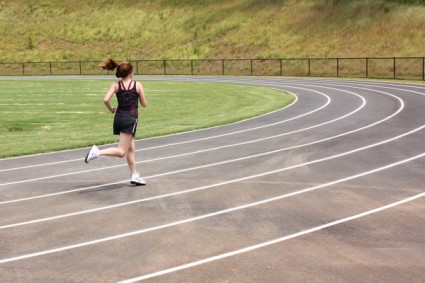You either love running on a track or hate it. The fact is, training on it can improve your training tremendously, if you know what you’re doing.
Visiting the track just once a week, or even once every other week, will do the trick. So if you don’t like the track workouts now, hopefully you’ll grow to like them. If you can’t learn to like them, you can certainly toughen up once every week or every two weeks and get through it!
What does track running give you that you can’t get from road running? Track running will help you correlate perceived effort with pace. You will benefit from running at a faster pace than you’re used to, suffering along the way – in the name of gain – and surviving. Track running allows you to run fast, uninterrupted sessions and offers you a flat, smooth surface to do so. It gives you a place to concentrate on your effort and thoughts rather than where your foot will land. You don’t have to worry about traffic, hills, blind turns or any other interruptions you may encounter on the road. It also provides a comfortable environment to carry out your technical drills.
As a general rule, each track workout should include a warm up, some drills, the main set and then a cool down. It is very important to not skip a warm up when going into a track session. Any stretching you need to do should also be done after a brief warm up. A standard track session might look like this:
- Warm up: 10-15 minutes easy
- Stretching
- Drills: High knees, butt kicks, cariocas, high skips, windsprints
- Main Set: # of repetitions of a certain distance with a set rest
- Cool down: 10-15 minutes easy
Track Running: Getting Started
If you are just getting started, break yourself in gently. Wear good racing or training shoes, and run a few miles at a steady pace to get used to the surface and line markings at first. Here are some suggestions that benefit triathletes:
- Aerobic Speed – This aerobic session is teaching the heart to pump and the muscles to use oxygen to burn fuel. It is best to start with short repetitions and build the length of time you are running at this pace. Here are some examples of how to progress your main sets:
Session 1: 2x (10x200m) with 20 seconds between reps and 4 minutes between sets
Session 2: 3x (5x300m) with 45 seconds between reps and 4 minutes between sets
Session 3: 2x (6x400m) with 1 minute between reps and 3 minutes between sets
Session 4: 1x (2x400m) with 1 minute rests
- Aerobic Endurance – There is a definite advantage in running for over 3 minutes in each repetition as you will have your heart rate higher for longer periods of time. Examples of fast aerobic endurance sessions include:
Session 1: 8x800m with 2 minutes rest
Session 2: 6x (800m/400m) alternating 2 minutes rest and 1minute rest
Session 3: 8x1km with 2 minutes rest
Session 4: 6×1.2km with 2 minutes rest
- Anaerobic workouts – Train at these paces and you will be developing your ability to apply quick force to the track, increasing your stride length and efficiency. If you do a big fast aerobic session once a week, and have developed a good endurance base over time, you will find that it doesn’t take many of these anaerobic sessions to produce a rapid performance improvement. Just 6 to 10 sessions will move you on significantly. The key is to be fresh and fueled when you do them.
Session 1: 10x200m with 90 seconds rest between reps
Session 2: 7x300m with 2 minutes rest between reps
Session 3: 6x400m with 2.5 minutes between reps
Think of the track as your test for pushing your run performances further to achieve faster times. Keep it interesting and challenging by changing the sessions and combining different elements at different paces. If you need help with improving your run or would like help with your triathlon training, contact me today.







